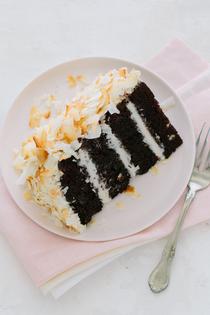The Kitchn: What you should know about baking with coconut oil
If coconut oil has a regular place in your pantry, you may already know what a treat it can be to bake with. While it's a staple in vegan desserts, you certainly don't have to follow a special diet to work this fragrant oil into your cakes, cookies and muffins. Coconut oil is a versatile baking staple; here's what you should know about making it work for you.
1. Coconut oil has a melting point of 76 F. Unlike other oils, coconut oil can be liquid or solid -- it all depends on the temperature where it's stored. When stored below 76 F, it will firm up and solidify; at a higher temperature, it will melt into a liquid.
2. Coconut oil can be substituted 1:1 for other fats. When it comes to baking, coconut oil makes a wonderful substitute for butter and other oils, like olive oil, canola oil and vegetable oil. Regardless of the type of fat used in a recipe, you can swap in an equal amount of coconut oil.
3. You can use solid, room-temperature coconut oil in place of butter. Depending on the temperature at which it's stored, coconut oil can be liquid or solid. (See number one, above). In its solid state, coconut oil has a texture most similar to butter.
When substituting butter with coconut oil, use solid, room-temperature coconut oil. This is especially important when using coconut oil to make pie crust -- the chilled, solid oil should be cut into the flour just as you would with butter.
4. You should use room-temperature ingredients when baking with coconut oil. When mixed with cold ingredients, liquid coconut has a tendency to seize up and coagulate. The best way to prevent this from happening is to bring other ingredients, like milk and eggs, to room temperature before mixing ingredients together.
5. Coconut oil can also be used to grease baking pans. Because coconut oil has a relatively high smoke point, it can also be used to grease cake pans, muffin tins and baking dishes. Use a pastry brush or paper towel to spread a thin coating over the surface of bakeware.
6. Tasting the coconut oil is optional. The wonderful thing about baking with coconut oil is that you can control the coconut flavor. It all depends on the type you use, which depends on personal preference.
--Unrefined coconut oil (sometimes also referred to as virgin or pure coconut oil) is extracted from fresh coconut meat, undergoes minimal processing, and retains the distinct odor and flavor of coconut.
--Refined coconut oil, on the other hand, is extracted from dried coconut meat. This type of coconut oil undergoes high-heat processing, which removes the coconut odor and flavor.
(Kelli Foster is an assistant food editor for TheKitchn.com, a nationally known blog for people who love food and home cooking. Submit any comments or questions to editorial@thekitchn.com.)







